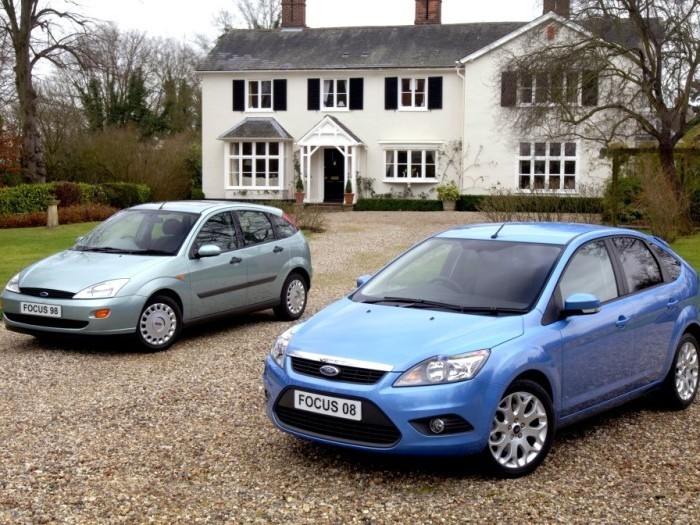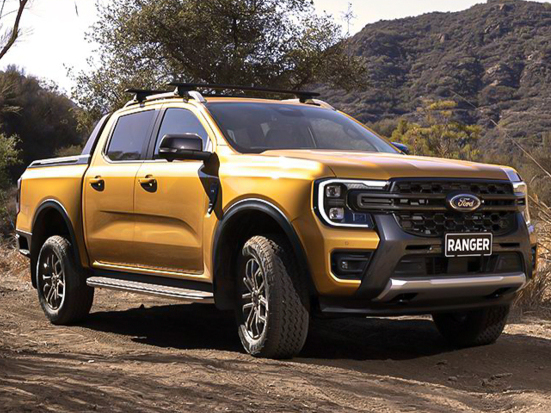Q
How many miles can Ford Focus travel on a full tank?
The fuel tank capacity of the 1.5-liter EcoBoost Titanium Plus sedan version of the Ford Focus is 55 liters, and the official combined fuel consumption is 5.6 liters per 100 kilometers. To calculate how many kilometers it can travel on a full tank of gas, we divide the fuel tank capacity by the fuel consumption rate: 55 liters divided by 5.6 liters per 100 kilometers, which is approximately 982 kilometers.
To convert kilometers to miles, we use the conversion factor, where 1 kilometer is approximately equal to 0.621371 miles. So, 982 kilometers is approximately 982 × 0.621371 = 609 miles. Therefore, under official combined driving conditions, a Ford Focus can travel approximately 609 miles on a full tank of gas. Please note that the actual driving range may vary depending on driving habits, road conditions, and vehicle load.
Special Disclaimer: This content is published by users and does not represent the views or position of PCauto.
Related Q&A
Q
What's the fuel consumption of Ford Focus?
The official combined fuel consumption of the 2017 Ford Focus 4-door sedan with a 1.5-liter EcoBoost engine, Titanium Plus Edition, is 5.6 liters per 100 kilometers. This figure is measured under specific test conditions stipulated by the manufacturer. However, in real-world driving, the actual fuel consumption can vary due to multiple factors.
For instance, driving style has a significant impact on fuel consumption. An aggressive driving style with frequent rapid acceleration and hard braking usually leads to higher fuel consumption, while smooth and constant-speed driving helps save fuel. Road conditions also play a role. Compared with driving on a flat highway with light traffic, driving on hills or in heavy traffic typically increases fuel consumption.
In addition, vehicle load, tire pressure, and the use of accessories such as the air - conditioning system can all affect the actual fuel consumption of the Ford Focus.
Q
What's the service life of Ford Focus' petrol engine?
The service life of the gasoline engine in the Ford Focus can be different. Generally speaking, if properly maintained, the service life of gasoline engine can last for more than 150,000 to 200,000 miles (about 240,000 to 320,000 kilometers) or even longer. The Ford Focus 1.5 EcoBoost Titanium+ is equipped with a 1498 - cc gasoline engine.
Regular oil changes are crucial because fresh oil lubricates the engine components, reducing friction and wear. Replacing filters, such as the air filter and fuel filter, also enables the engine to take in clean air and get the proper fuel mixture. Timely replacement of belts and hoses that age over time helps prevent unexpected breakdowns. Maintaining good driving habits is also important. Aggressive driving with sudden acceleration and hard braking will damage the engine, while smooth driving can extend the engine's service life. Additionally, following the manufacturer's maintenance schedule for the engine (for the Ford Focus, it might be maintenance at regular intervals of mileage or time) can ensure the engine stays in good working condition over the long term.
Q
Which one is better, Honda Civic or Ford Focus?
The Honda Civic and the Ford Focus each have their own advantages, making it difficult to simply judge which one is better. In terms of appearance, the front end of the Ford Focus has a dynamic design. Its large - sized aluminum alloy wheels are well - matched with the sporty taillight group, giving the car an overall fashionable and tech - savvy look. On the other hand, the Honda Civic may have a more simple and smooth shape.
When it comes to the interior, the Focus' 13.2 - inch floating central control screen creates an excellent technological atmosphere. It also comes with a large - sized sunroof, automatic air - conditioning and other complete configurations. The Civic's interior perhaps focuses more on the balance between comfort and practicality.
In terms of power, the Focus offers a variety of power options, including different turbocharged engines, providing plenty of driving fun. The Civic's power performance can also meet the needs of daily driving, and it may perform well in terms of fuel economy.
The prices of the two cars also vary depending on the specific models and configurations. It is recommended that you go to a dealership to test - drive these two models in person, experience their actual driving feelings, and then select the most suitable model for yourself based on factors such as your budget and your preferences for the appearance and interior.
Q
Is Ford Focus smaller than Corolla?
The 2017 Ford Focus Sedan 1.5 EcoBoost Titanium+ measures 4,534mm in length, 1,823mm in width, and 1,484mm in height, with a wheelbase of 2,648mm. The dimensions of the Corolla vary depending on the version and year. Generally, its length ranges from 4,300mm to 4,600mm, width from 1,700mm to 1,800mm, height from 1,450mm to 1,500mm, and wheelbase typically from 2,600mm to 2,700mm. As we can see, the Ford Focus is bigger than the common Corolla in length, width, height, and also longer in wheelbase.
However, the interior space of a car isn't solely determined by its exterior dimensions. Factors such as the in - car layout design also play a role in the actual space experience. Moreover, there are differences in the dimensions among different Corolla models. A detailed comparison requires the accurate parameters of the actual models. But when compared with the above - mentioned models, the Ford Focus has larger overall dimensions.
Q
Which one is better, Mazda 3 or Ford Focus?
Both Mazda 3 and Ford Focus have their own advantages, so which one is better depends on individual needs and preferences. In terms of price, if you have a limited budget, the Focus might be more suitable as it is relatively affordable. When it comes to configuration, the Mazda 3 has more abundant safety features. Even the base - model is equipped with a tire pressure monitoring system and a vehicle stability control system. Regarding power performance, the Focus is powered by a 1.5 - liter naturally - aspirated engine, while the Mazda 3 offers a choice between a 1.5L and a 1.4T engine, and the 1.4T engine provides stronger power. In terms of exterior design, the Focus has a more masculine look, while the Mazda 3 is more appealing to women. Moreover, the seams on the Mazda 3's center console are more delicate. In terms of space, some testers think that the Mazda 3 has a slight edge in headroom and legroom. All in all, if you focus on price and practicality, the Focus is a good option. However, if you prefer rich configurations and strong power, the Mazda 3 may be a better choice.
Q
What is the fuel economy of Ford Focus?
The official fuel consumption of the 2017 Ford Focus sedan 1.5-liter EcoBoost Titanium Plus Edition is 5.6 liters per 100 kilometers. This figure represents the combined fuel consumption under standard test conditions. In real-world driving, the fuel consumption may vary, which can be affected by factors such as driving style, road conditions, and vehicle load. For example, an aggressive driving style with rapid acceleration and hard braking may increase fuel consumption, while a smoother and more stable driving style may make the actual fuel consumption closer to the official data. Additionally, using features such as the air conditioner and having an excessive vehicle load can also affect the car's fuel consumption. The Focus's fuel consumption of 5.6 liters per 100 kilometers makes it a relatively fuel-efficient model in the compact car segment, helping car owners reduce their vehicle usage costs.
Q
Which model of Ford Focus is the best?
As the criteria for "the best" vary from different people, so it's quite difficult to directly determine which model is the best. Take the 2017 Ford Focus Sedan 1.5 EcoBoost Titanium+ as an example. It is equipped with rich configurations. In terms of power, the 1.5 - liter engine has a maximum horsepower of 182PS. The maximum speed can reach 222km/h, and it can accelerate from 0 to 100km/h in 8.6 seconds. Its power output has certain advantages among cars in the same class. Regarding safety features, it is standard - equipped with a series of safety systems such as ABS anti - lock brakes, vehicle stability control, and lane - change assist, and also has six airbags to comprehensively ensure the safety of drivers and passengers. There are also quite a few comfort features inside the car, like the dual - zone automatic air - conditioning in the front row and Sony speakers. However, if consumers pay more attention to fuel economy, its official combined fuel consumption of 5.6L/100km is quite good. If they prefer space, its 421L trunk volume is just average. So, the best model depends on individual's preferences.
Q
Is Ford Focus a small or mid-size car?
The Ford Focus is a small car, specifically a C-segment or compact sedan. It has a body length of 4,534 millimeters, a width of 1,823 millimeters, a height of 1,484 millimeters, and a wheelbase of 2,648 millimeters. These dimensions are typical specifications for a compact sedan. In the automotive classification, compared with mid-size or large vehicles, compact sedans are known for their relatively small size, which makes them easier to be driven in the city.
Compact sedans like the Ford Focus are popular among many consumers for their affordable price, good fuel economy, and easy parking. The Ford Focus is an excellent choice for daily commuting and city driving. And as a compact sedan, it also offers an ample interior space and features, such as a 55-liter fuel tank and 421 liters of trunk space.
Q
How far can a Ford Focus travel on an empty fuel tank?
Generally speaking, it's not recommended to drive your car until the fuel runs out completely, as this can potentially damage components like the fuel pump. However, in theory, if we estimate based on the information of the 2017 Ford Focus Sedan 1.5 EcoBoost Titanium+, its fuel tank capacity is 55 liters, and the official combined fuel consumption is 5.6 liters per 100 kilometers. Calculated at this fuel - consumption level, the theoretical driving range of this car when the tank is full is about 982 kilometers.
However, the actual range is affected by various factors. For example, driving style is an important factor. Frequent hard acceleration and sudden braking increase fuel consumption and reduce the range. Road conditions also play a role. Driving in congested traffic or on mountain roads can cause the fuel consumption to go up. Vehicle load is another factor. Having more passengers or carrying a large amount of items in the car will make it "thirstier" for fuel. So, in actual use, the range of this car will be less than the theoretical value, and the specific figure depends on the actual driving conditions.
Q
What is special about Ford Focus?
The Ford Focus has many distinctive features. It is equipped with a 1.5-liter EcoBoost engine that strikes a great balance between performance and efficiency. The maximum speed can reach up to 222 km/h, and the official 0 - 100 km/h acceleration time is 8.6 seconds. Meanwhile, the official combined fuel consumption is relatively low, at 5.6 liters per 100 kilometers.
In terms of safety, it is equipped with a series of standard features, such as six airbags, an Anti-lock Braking System (ABS), a Vehicle Stability Control system, and a variety of active safety systems. Comfort and convenience are also well - guaranteed. It offers a dual - zone automatic air - conditioning system and a Sony audio system for the front row, along with keyless operation and a single sunroof.
The interior design focuses on ergonomics, creating a "flight cockpit" feel. The 60:40 split - folding rear seats enhance the vehicle's practicality. Moreover, the exterior features a modern and dynamic design with sharp lines, which has won the favor of many consumers.
Latest Q&A
Q
What is the cheapest 2024 Range Rover?
In the Malaysian market, the most affordable model of the 2024 Range Rover lineup is the Range Rover Evoque. The starting price of its entry - level version is around RM400,000, and the actual price may vary depending on the configuration, optional accessories, and dealer promotions. As the entry - level SUV in the Range Rover family, the Evoque retains the brand's iconic luxury design language and off - road capabilities. It is also equipped with an efficient turbocharged engine and advanced technological features, such as the Pivi Pro infotainment system and the Terrain Response all - terrain feedback system, making it a great fit for both city driving in Malaysia and occasional outdoor adventures. If you have a limited budget but still want to experience the luxury of Range Rover, the Evoque is a good option. Meanwhile, the Range Rover Velar in the same series is positioned a bit higher, with a starting price of approximately RM500,000, offering more spacious interiors and a wider range of features. When purchasing in Malaysia, it's advisable to compare the promotional offers from different dealers and take into account the long - term maintenance costs, as luxury cars generally have higher upkeep expenses. However, Range Rover has a good reputation for reliability and after - sales service in the local market.
Q
Will the Range Rover Evoque change in 2024?
Based on the current information, the 2024 Range Rover Evoque is expected to undergo some updates, but there may not be significant changes to the overall design. The updates will mainly focus on the optimization of technological features and the powertrain. For example, it might upgrade the infotainment system or incorporate more efficient mild - hybrid technology to meet global emission standards. In the Malaysian market, this vehicle is likely to maintain its popular position as a luxury compact SUV and adapt to local road conditions and consumer preferences. For instance, it could offer seat materials suitable for the tropical climate or an enhanced air - conditioning system. The Range Rover Evoque has always been known for its stylish design and off - road capabilities. The 2024 model may further enhance these features while maintaining the brand's consistent high - quality. Malaysian consumers can look forward to an even better driving experience through detailed improvements while retaining the existing advantages. As for the specific changes, we still need to wait for the official announcement for confirmation.
Q
What is the Range Rover Evoque 2024?
The 2024 Range Rover Evoque is a luxury compact SUV under Land Rover. It continues the brand's iconic refined design and outstanding performance, and is specifically designed for urban driving and mild off - road needs. This vehicle has attracted a lot of attention in the Malaysian market. The 2024 model is expected to be equipped with a more efficient mild - hybrid or plug - in hybrid system, which will further improve fuel economy while maintaining Land Rover's consistent all - terrain capabilities. It comes with the Terrain Response all - terrain feedback system, making it suitable for Malaysia's diverse road conditions.
In terms of the interior, the new car is expected to use high - end leather and metal trims, and be equipped with the latest Pivi Pro infotainment system, which supports wireless Apple CarPlay and Android Auto to meet the needs of tech enthusiasts. The body design continues the Evoque's classic floating roof and hidden door handles, highlighting a sense of fashion.
For Malaysian consumers, the compact size of the Evoque is very suitable for city driving. At the same time, its luxury features and brand premium also meet the local preference for high - end SUVs. It's worth mentioning that Land Rover has a well - established dealer network and after - sales service in Malaysia, providing reliable support for car owners. As an entry - level Land Rover model, the Evoque also gives more consumers the opportunity to experience the brand's luxury and performance.
Q
How much is a 2024 Range Rover Evoque?
The pricing of the 2024 Range Rover Evoque in Malaysia varies depending on the configuration. It's estimated to start from around RM280,000 to RM350,000. The exact price depends on the selected model (such as the S, SE, or HSE versions), the powertrain (like the 2.0-liter turbocharged petrol or diesel engine), and additional features (such as premium interiors and driver assistance systems).
This vehicle continues the Land Rover family's exquisite design. It comes equipped with the latest Pivi Pro infotainment system and the Terrain Response System, making it suitable for both city driving and light off - road adventures. In the Malaysian market, the Evoque is well - received for its luxury and practicality. Local agents also offer a variety of financial packages and warranty services, making it convenient for consumers to make a choice.
It's important to note that before purchasing, it's advisable to confirm the latest prices and promotional activities with authorized dealers, as the prices may be affected by exchange rates, taxes, or configuration updates. Additionally, the maintenance cost of the Evoque is relatively high, but the service packages provided by Land Rover Malaysia can help owners reduce long - term maintenance expenses.
Q
How often should a Mercedes GLC 2024 be serviced?
According to Mercedes-Benz's official maintenance recommendations, under normal operating conditions in Malaysia, the 2024 GLC should undergo regular maintenance every 10,000 kilometers or 12 months, whichever comes first. The hot and humid climate in Malaysia, along with the congested urban traffic, may accelerate the wear and tear of engine oil and filters. Therefore, it is recommended that car owners shorten the maintenance interval to every 8,000 - 10,000 kilometers. Special attention should be paid to checking the air - conditioning system, brake fluid, and battery status.
The turbocharged engine in this model has high requirements for engine oil quality. It is essential to use fully synthetic engine oil that meets the MB - Approval 229.51/229.52 standards. In addition to regular maintenance, it is advisable to check the wheel alignment and brake pad thickness every 20,000 kilometers. Before the rainy season, pay special attention to the sunroof drain pipes and anti - rust treatment of the chassis.
The Service Care package offered by authorized dealers in Malaysia usually includes 15 core inspection items, which comprehensively cover the inspection of the transmission system, electronic devices, and safety configurations. If you often drive long distances or in dusty environments, you may consider replacing the air filter earlier.
It should be noted that strictly following the maintenance manual not only helps maintain the vehicle's optimal performance but also extends the original factory warranty. For hybrid models, it is even more crucial to conduct special inspections of the high - voltage system on schedule.
View MoreRelated News

Ford Focus will cease production in 2025, shifting strategic emphasis towards electrification
Kevin WongMar 10, 2025

Ford Focus is about to cease production in November and may return in 2027 in the form of an SUV.
WilliamSep 15, 2025

2025 Ford Ranger WildTrak launched, the most powerful diesel version in the Ranger lineup
MichaelAug 25, 2025

Is the Ford Ranger V6 about to enter Malaysia?
LienAug 13, 2025

Reviewing the Ford Ranger: The Dual Advantages of Rugged Appearance and Powerful Performance
Kevin WongApr 21, 2025
View More

















Pros
Cons